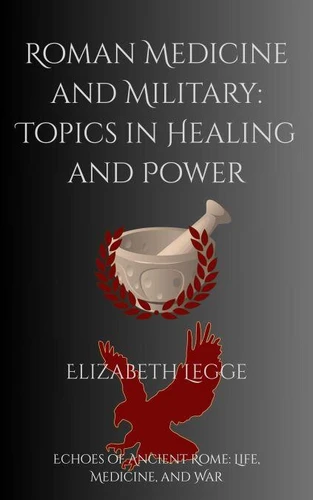Roman Medicine and Military: Topics in Healing and Power. Echoes of Ancient Rome: Politics, Medicine, and War
Par :Formats :
Disponible dans votre compte client Decitre ou Furet du Nord dès validation de votre commande. Le format ePub est :
- Compatible avec une lecture sur My Vivlio (smartphone, tablette, ordinateur)
- Compatible avec une lecture sur liseuses Vivlio
- Pour les liseuses autres que Vivlio, vous devez utiliser le logiciel Adobe Digital Edition. Non compatible avec la lecture sur les liseuses Kindle, Remarkable et Sony
 , qui est-ce ?
, qui est-ce ?Notre partenaire de plateforme de lecture numérique où vous retrouverez l'ensemble de vos ebooks gratuitement
Pour en savoir plus sur nos ebooks, consultez notre aide en ligne ici
- FormatePub
- ISBN8230386278
- EAN9798230386278
- Date de parution31/03/2025
- Protection num.pas de protection
- Infos supplémentairesepub
- ÉditeurIndependently Published
Résumé
This book explores three interwoven topics related to ancient Roman medical practice and aspects of the Roman military, shedding light on themes often overlooked in historical accounts. It is comprised of three treatises: Ancient Roman Women Physicians: Long thought to have played a negligible role in Roman history, archaeological evidence and ancient documents reveal that women physicians were as equally honoured and respected as and by their male colleagues.
These pioneering medicae held significant positions in Roman healthcare, contributing to the advancement of medicine and society. Roman Military Medicine: Remarkably sophisticated, Roman military medicine included a range of practitioners, medical training, and advanced surgical techniques. This section delves also discusses the instruments used, such as scalpels and probes, as well as the ongoing debate surrounding valetudinaria (military hospitals).
Roman surgical kits were virtually identical to modern ones, demonstrating the ingenuity of ancient Roman medicine. Castra Praetoria: An examination of the structure and topography of the Castra Praetoria in Rome, the barracks constructed by the Praetorian Prefect Aelius Sejanus in AD 23. These barracks brought the Roman military cohorts and the Praetorian Guard together in one strategic location, ensuring rapid access to the city's centre while projecting Imperial authority.
NOTE: This book is a compilation of my previously published works: Roman Women Physicians, Roman Military Medicine from an Archaeological and Historical Perspective, and The Structure and Phases of the Castra Praetoria in Rome. Upgraded with illustrations and diagrams, it combines these topics smoothly. The written contents are the same, however, making it unnecessary to purchase both.
These pioneering medicae held significant positions in Roman healthcare, contributing to the advancement of medicine and society. Roman Military Medicine: Remarkably sophisticated, Roman military medicine included a range of practitioners, medical training, and advanced surgical techniques. This section delves also discusses the instruments used, such as scalpels and probes, as well as the ongoing debate surrounding valetudinaria (military hospitals).
Roman surgical kits were virtually identical to modern ones, demonstrating the ingenuity of ancient Roman medicine. Castra Praetoria: An examination of the structure and topography of the Castra Praetoria in Rome, the barracks constructed by the Praetorian Prefect Aelius Sejanus in AD 23. These barracks brought the Roman military cohorts and the Praetorian Guard together in one strategic location, ensuring rapid access to the city's centre while projecting Imperial authority.
NOTE: This book is a compilation of my previously published works: Roman Women Physicians, Roman Military Medicine from an Archaeological and Historical Perspective, and The Structure and Phases of the Castra Praetoria in Rome. Upgraded with illustrations and diagrams, it combines these topics smoothly. The written contents are the same, however, making it unnecessary to purchase both.
This book explores three interwoven topics related to ancient Roman medical practice and aspects of the Roman military, shedding light on themes often overlooked in historical accounts. It is comprised of three treatises: Ancient Roman Women Physicians: Long thought to have played a negligible role in Roman history, archaeological evidence and ancient documents reveal that women physicians were as equally honoured and respected as and by their male colleagues.
These pioneering medicae held significant positions in Roman healthcare, contributing to the advancement of medicine and society. Roman Military Medicine: Remarkably sophisticated, Roman military medicine included a range of practitioners, medical training, and advanced surgical techniques. This section delves also discusses the instruments used, such as scalpels and probes, as well as the ongoing debate surrounding valetudinaria (military hospitals).
Roman surgical kits were virtually identical to modern ones, demonstrating the ingenuity of ancient Roman medicine. Castra Praetoria: An examination of the structure and topography of the Castra Praetoria in Rome, the barracks constructed by the Praetorian Prefect Aelius Sejanus in AD 23. These barracks brought the Roman military cohorts and the Praetorian Guard together in one strategic location, ensuring rapid access to the city's centre while projecting Imperial authority.
NOTE: This book is a compilation of my previously published works: Roman Women Physicians, Roman Military Medicine from an Archaeological and Historical Perspective, and The Structure and Phases of the Castra Praetoria in Rome. Upgraded with illustrations and diagrams, it combines these topics smoothly. The written contents are the same, however, making it unnecessary to purchase both.
These pioneering medicae held significant positions in Roman healthcare, contributing to the advancement of medicine and society. Roman Military Medicine: Remarkably sophisticated, Roman military medicine included a range of practitioners, medical training, and advanced surgical techniques. This section delves also discusses the instruments used, such as scalpels and probes, as well as the ongoing debate surrounding valetudinaria (military hospitals).
Roman surgical kits were virtually identical to modern ones, demonstrating the ingenuity of ancient Roman medicine. Castra Praetoria: An examination of the structure and topography of the Castra Praetoria in Rome, the barracks constructed by the Praetorian Prefect Aelius Sejanus in AD 23. These barracks brought the Roman military cohorts and the Praetorian Guard together in one strategic location, ensuring rapid access to the city's centre while projecting Imperial authority.
NOTE: This book is a compilation of my previously published works: Roman Women Physicians, Roman Military Medicine from an Archaeological and Historical Perspective, and The Structure and Phases of the Castra Praetoria in Rome. Upgraded with illustrations and diagrams, it combines these topics smoothly. The written contents are the same, however, making it unnecessary to purchase both.


















